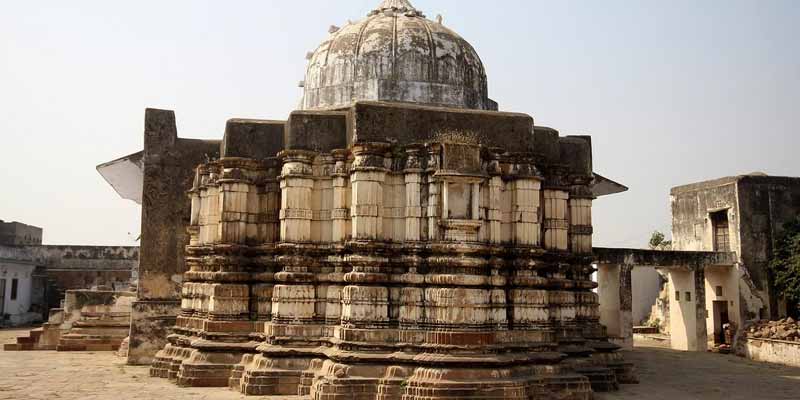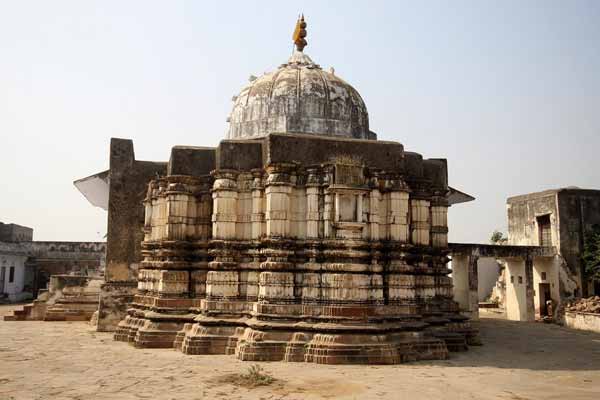Varaha Temple Pushkar is a prominent Hindu temple dedicated to Lord Varaha, an incarnation of Lord Vishnu in the form of a boar. Situated on the outskirts of the sacred Pushkar Lake in the state of Rajasthan, India, this temple holds significant religious importance and attracts devotees and tourists alike.
Constructed in the early 12th century, the Varaha Temple showcases exquisite Rajput architecture with intricate carvings and sculptures. The main sanctum of the temple houses a captivating idol of Lord Varaha, depicting the deity in a boar form, rescuing the Earth goddess, Bhudevi. The idol is adorned with beautiful ornaments, adding to its divine aura, Pushkar Tour Packages.
The temple premises also feature other deities and sculptures, contributing to the rich cultural and religious heritage of the region. The Varaha Temple Pushkar is not only a place of worship but also a site of historical and architectural significance, drawing visitors who appreciate the blend of spirituality and artistry. The serene ambiance near the temple, coupled with its historical charm, makes it a must-visit destination for those exploring the religious and cultural tapestry of Pushkar Tour Planner.

History of Varaha Temple, Pushkar
The Varaha Temple in Pushkar has a rich history that dates back to the 12th century. Dedicated to Lord Varaha, the third incarnation of Lord Vishnu, the temple stands as a testament to the architectural and religious heritage of the region.
Built in the Pratihara style of architecture, the Varaha Temple Pushkar is believed to have been constructed during the reign of King Anaji Chauhan in the early 12th century. The temple’s design and intricate carvings showcase the artistic brilliance of the medieval period in Rajasthan. The temple’s location near the sacred Pushkar Lake adds to its spiritual significance.
The main sanctum of the temple houses a captivating idol of Lord Varaha, depicting the deity in the form of a boar. According to Hindu mythology, Varaha rescued the Earth goddess, Bhudevi, from the demon Hiranyaksha. The idol in the temple portrays this divine episode, and devotees flock to the shrine to seek blessings and witness the religious narrative come to life through the sculptures.
Over the centuries, the Varaha Temple has undergone renovations and restorations, ensuring its preservation for future generations. Today, the temple continues to be a revered pilgrimage site and a cultural gem, attracting both religious devotees and enthusiasts interested in the historical and architectural splendor of Pushkar Fair. The Varaha Temple stands as a symbol of devotion, craftsmanship, and the enduring spiritual legacy of the region.
Architechture of Varaha Temple Pushkar
The Varaha Temple in Pushkar boasts a splendid architectural style that reflects the artistic finesse of the medieval period in Rajasthan. Constructed in the Pratihara style, the temple exemplifies the architectural heritage prevalent during the 12th century.
The temple’s exterior is adorned with intricate carvings and sculptures, showcasing the mastery of Rajput artisans. The main entrance is marked by an ornate torana (archway) adorned with detailed sculptures depicting various mythological scenes and deities. The torana leads to the mandapa (hall), which is supported by intricately carved pillars.
The sanctum sanctorum, where the main deity Lord Varaha is enshrined, features a pyramidal shikhara (spire) with sculpted elements that add to the temple’s grandeur. The idol of Lord Varaha, in the form of a boar, is the focal point of the inner sanctum, depicting the divine episode of Varaha rescuing Bhudevi, the Earth goddess.
The temple’s walls are adorned with friezes illustrating scenes from Hindu mythology and legends, providing a visual narrative for devotees and visitors. The overall layout and design of the Varaha Temple exemplify the fusion of spirituality and artistry, creating a sacred space that not only serves as a place of worship but also as an architectural masterpiece.
Despite the passage of centuries, the Varaha Temple Pushkar has retained its architectural charm through careful restoration efforts, allowing visitors to appreciate the rich cultural and historical legacy embedded in its design. The temple stands as a testament to the architectural brilliance of the past and continues to be a revered site in Pushkar, attracting admirers of art, history, and spirituality alike.
Places to Visit Near Varaha Temple
Pushkar, a town with a rich cultural and spiritual heritage, offers several attractions near the Varaha Temple for visitors to explore. Here are some notable places to visit in the vicinity:
Pushkar Lake: Just a stone’s throw away from the Varaha Temple, Pushkar Lake is a sacred water body surrounded by ghats and temples. Pilgrims often take a dip in its holy waters, and the lake provides a serene setting for leisurely walks.
Brahma Temple: Dedicated to Lord Brahma, the creator in Hinduism, this temple is one of the very few Brahma temples in the world. It is located close to the Varaha Temple and is a significant pilgrimage site.
Savitri Temple: Perched on a hill, the Savitri Temple offers panoramic views of Pushkar and its surroundings. The trek to the temple provides a scenic experience, and the architecture is noteworthy.
Rangji Temple: This temple is a blend of South Indian and Rajput architectural styles. Dedicated to Lord Rangji (a form of Lord Vishnu), it showcases intricate carvings and is a visually appealing site.
Pushkar Bazaar: A bustling market near the Varaha Temple Pushkar Bazaar offers a variety of goods, including traditional Rajasthani handicrafts, jewelry, textiles, and souvenirs. It’s an excellent place to experience the local culture and shop for unique items.
Man Mahal: Built by Raja Man Singh I, this palace near Pushkar Lake is an architectural marvel. It now serves as a heritage hotel, and its historical significance adds to its charm.
Aptaeshwar Temple: Dedicated to Lord Shiva, this ancient temple features intricate carvings and is less crowded than some of the more prominent temples in Pushkar.
Exploring these attractions near the Varaha Temple not only offers a deeper understanding of the town’s cultural and religious significance but also provides a delightful mix of history, spirituality, and natural beauty.
How to Reach Varaha Temple Pushkar
Pushkar, a town in the state of Rajasthan, India, is well-connected by road and can be reached from various nearby cities. Here’s how you can reach Varaha Temple in Pushkar:
By Air: The nearest airport to Pushkar is the Jaipur International Airport (JAI), which is approximately 150 kilometers away. From the airport, you can hire a taxi or use other local transportation to reach Pushkar.
By Train: Ajmer Junction is the nearest railway station to Pushkar, located around 11 kilometers away. Ajmer is well-connected to major cities in India. From Ajmer, you can hire a taxi or take a local bus to reach Pushkar. Some trains may also have a stop at the smaller Pushkar Terminus.
By Road: Pushkar has good road connectivity, and you can reach the town by bus or car. The town is well-connected to major cities in Rajasthan. The nearest major bus stand is in Ajmer, from where you can take a local bus or hire a taxi to reach Pushkar.
If you are traveling by car, Pushkar is accessible by road from cities like Jaipur, Jodhpur, and Udaipur. National Highway 48 and other state highways connect Pushkar to various parts of Rajasthan.
Local Transportation in Pushkar: Once you reach Pushkar, you can explore the town on foot, as the Varaha Temple and many other attractions are within walking distance. Auto-rickshaws and cycle rickshaws are also available for short distances, and taxis can be hired for more extended journeys.
It’s always a good idea to check the current transportation options and schedules before planning your trip to ensure a smooth and convenient journey to Varaha Temple Pushkar.
